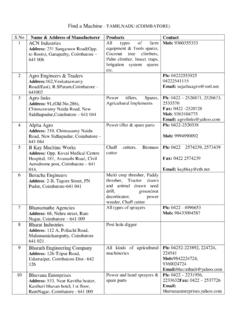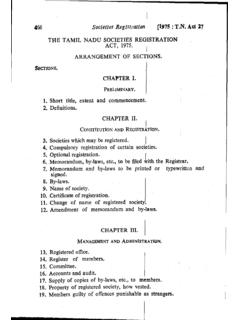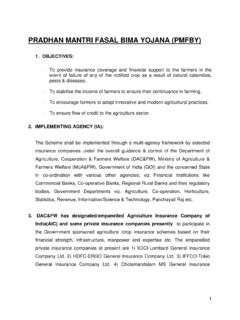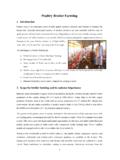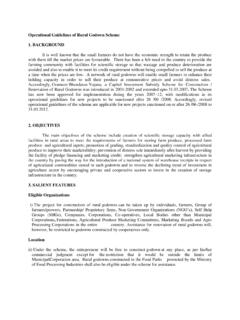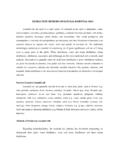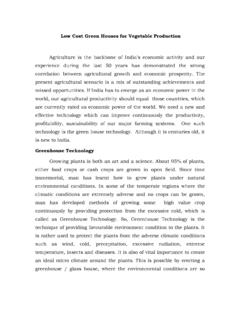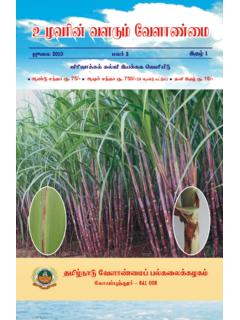Transcription of Micronutrients for horticultural crops - TNAU Agritech Portal
1 Micronutrients FOR horticultural crops . P. Jeyakumar and Balamohan Department of Fruit crops , horticultural College and Research Institute Tamil Nadu Agricultural University, Coimbatore 641 003. The nutrient elements which are required comparatively in small quantities are called as micro or minor nutrients or trace elements. Micronutrients are essentially as important as macronutrients to have better growth, yield and quality in plants. The requirement of Micronutrients (boron, iron, copper, zinc, manganese, chloride and molybdenum) is only in traces, which is partly met from the soil or through chemical fertilizer or through other sources. The major causes for micronutrient deficiencies are intensified agricultural practices, unbalanced fertilizer application including NPK, depletion of nutrients and no replenishment. horticultural crops suffer widely by zinc deficiency followed by boron, manganese, copper, iron (mostly induced) and Mo deficiencies.
2 Cl, Cu, Fe and Mn are involved in various processes related to photosynthesis and Zn, Cu, Fe, and Mn are associated with various enzyme systems; Mo is specific for nitrate reductase only. B is the only micronutrient not specifically associated with either photosynthesis or enzyme function, but it is associated with the carbohydrate chemistry and reproductive system of the plant. The significance of Micronutrients in growth as well as physiological functions of horticultural crops fruits are briefed here nutrient wise. 1. IRON. Plants need iron to produce chlorophyll and to activate several enzymes including those involved in the oxidation /reduction processes of photosynthesis and respiration. Iron concentrations of 50-100 ppm are often quoted as satisfactory leaf analysis values for most crops . But leaf analysis is not a reliable guide as there is poor mobility between tissues. Iron deficiency is rarely caused through insufficient iron in the soil but usually because it is rendered unavailable for the uptake by alkaline soil conditions or an excess of manganese or phosphorous.
3 Iron deficiency is a problem of high pH calcareous soils and is often described as lime induced chlorosis. Custard apples are relatively sensitive suffering from iron deficiency while other crops such as bananas are usually not affected much. This sensitivity appears to be related to crop's poor ability to absorb or utilise iron. The common deficiency symptoms include development of light green chlorosis of all the tissues between the veins. A distinctive pattern results from the network formed by the midrib and veins, which remain green for example, custard apples. If the chlorosis is severe and persistent, yellowing increases to the point of bleaching and burns can develop within this chlorotic area. Because iron does not move easily within the plant, older leaves can remain green while flushes of new growth are chlorotic. In pine apples, chlorosis is strongest towards the margins of young inner leaves. The fruits are small, reddish in colour, hard and prone to cracking.
4 The effects of iron deficiency in different fruit crops are discussed below. Banana: Banana requires more nutrients than any other commercially cultivated crop and various nutritional disorders affecting the yield and quality of banana have been reported. Iron deficiency is comparatively very rare in banana plantations. However, foliar spray of % ferrous sulphate checks the disorder effectively. The recent researches suggest that iron deficiency in banana can be identified using chlorophyll fluorescence. Fe deficiency decrease the ratio of variable fluorescence to maximum fluorescence as observed from fluorescence induction curves indicating the involvement of Fe in both chlorophyll biosynthesis as well as in components of phosphorylation. Citrus: The element acts as a catalyst in chlorophyll synthesis. The deficiency of iron causes network of green veins against a light green or yellow background in leaves followed by bronzing of leaves.
5 Grapes: The leaves turn yellow (chlorosis) during iron deficiency and the entire shoot become yellow to yellowish green under extreme conditions. The corrective measure is two sprays of ferrous sulphate, one before bloom and the second after fruit set. Papaya: Iron deficiency is comparatively very less in papaya. However, it is reported that foliar application of ferrous sulphate at monthly intervals from fifteen days after planting improved the total sugars and TSS of papaya. Pomegranate: Pomegranate responds well to foliar application of iron. Ferrous sulphate % prior to flowering, at full bloom and at fruit set increases the yield of fruits. Combined foliar application of % each of sulphates of zinc, ferrous and manganese with boric acid increased the yield and juice content. Tomato: Marginal and interveinal scorching develops on the young expanded leaves with slight purpling of the petioles and veins of chlorotic young leaves. Degreening of the smallest veins and irregular development of brown patches is also seen over the lamina.
6 Brinjal: Young as well as older leaves will exhibit chlorotic symptoms in the form of yellowing and there is a decline in photosynthesis due to which fruit yield will be greatly reduced. Foliar spray of solution containing 500g of ferrous sulphate and 100 g of urea dissolved in 100 lit of water added with 100 ml of soap solution for an acre of land is taken up two or three times at an interval of 20 days depending upon the degree of severity, to manage the disorder. Jasmine: The foliage will exhibit interveinal chlorosis as a result of iron deficiency in the soil. When the plant is infested with nematodes, availability of iron and other nutrients by translocation to the plant tissues is hampered due to blockage of vascular bundles. The leaves will have fade yellow colouration; the growth of the plant is stunted which may eventually lead to the wilting of the entire plant. The flower yield will be substantially reduced. Iron chlorosis is a common occurrence in jasmine as many of the areas where it is widely grown has been infested with nematode.
7 So, control of nematode infestation has to be taken up on priority basis. After digging the soil around the tree, the following are applied to the soil : 10 g of Temic or 20 g of Furadon, 250 g of Neem cake and 50 g of Murate of potash. It is followed by irrigation and application of Emisan solution. After one week, foliar application of 500 g of ferrous sulphate and 100g of urea along with 100 ml of soap solution mixed in 100 lit of water is done two to three times at 20. days interval depending upon the extent of severity. Crossandra: Crossandra is also affected by nematode induced chlorosis just like jasmine. In this crop, the typical symptom is characterized by the purple colouration of the leaves. The package of recommendation mentioned for jasmine also holds good in this case as well except for the fact that it is enough that half of the recommended chemicals is given. Brusselsprouts: Chlorosis of young leaves, reduced storage roots are the typical symptoms.
8 Foliar application of % of sulphates of iron checks the problem. Peas : Chlorosis of young leaves is the common symptom and the disorder can be managed well by foliar application of % ferrous sulphate. 2. ZINC. Zinc deficiency is the most widespread and limiting growth and yield in fruit crops . It commonly affects banana, custard apple and mangoes. Problems often appear in spring when crops are growing quickly but have difficulty in absorbing nutrients from cold soil. Zinc is important for the formation and activity of chlorophyll and in the functioning of several enzymes and the growth hormone, auxin. The severe stunting of leaves and shoots, which is so typical of zinc deficient crops is a consequence of low auxin levels in tissue. Young leaves are usually the most affected and are small, narrow, chlorotic and often rosetted due to failure of the shoot to elongate. Bloom spikes are small, deformed and drooping. In young pine apple plants, zinc deficiency is indicated by the young heart leaves bunching together and then tilting horizontally.
9 This condition is commonly called crook neck. Older plants may develop yellow spots and dashes near the margins of older leaves that eventually coalesce into brown blisterlike blemishes giving the leaf surface n uneven feel. The symptoms and corrective measures for zinc deficiency in different tropical fruit crops are mentioned below. Banana: Compared to other Micronutrients , Zn is the most commonly reported deficiency in banana plantations. A fruit yield of 50t/ha removes 500g of Zn/ha/year. In bananas, each successive leaf of the flush is smaller than the previous one and emerges with a reddish pink coloration on its underside. The opened leaf usually loses this pinkish colour but chlorotic bands develop parallel with lateral veins and alternate with green strips producing a rain bow leaf pattern. Due to imbalanced fertiliser application and high density planting, incidence of Zn deficiency has become yield limiting. Disproportionate and high application of DAP.
10 As basal and top dressing create P induced Zn deficiency in banana. The leaf width is reduced more than the length and the leaf becomes lanceolate in shape. Spraying of Zinc sulphate + urea at 45 and 60 days after planting of main crop and 45 days after cutting of mother plant for ratoon crop corrects the disorder well. In Zn deficient soils, application of Zinc sulphate @ 30-50g/plant at the time of planting is recommended. Recent studies at TNAU suggest that combined foliar spray of Zn ( ), Fe ( ), Cu ( ) and B ( ) influenced morphological, physiological and yield attributes. The treatment had significant improvement in bunch yield and quality parameters by showing higher total soluble solids and lower acidity. Mango: The major nutritional disorder in mango is little leaf caused by the deficiency of zinc. This leads to stunted growth of roots, shoots and leaves. The lamina of leaves turn pale yellow while midrib remain green. Leaves become very small, little with interveinal chlorosis.
